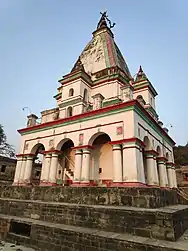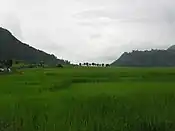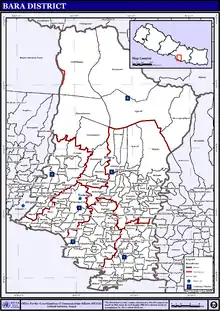Bara District
Bara District (Nepali: बारा जिल्ला ⓘ) is one of the seventy–seven districts of Nepal, located in the western part of the Madhesh Province. The district is third richest district in Nepal after Kathmandu and Morang with 3.3% share of total GDP of Nepal and highest per capita income in Madhesh province. Kalaiya serves as the district's headquarter.[1] Bakaiya, Jamuniya, Pasaha, Dudhaura and Bangari are the main rivers of Bara. The main languages spoken in the district are Bhojpuri, Bajjika, Tharu and Nepali.[2]
Bara District
बारा जिल्ला | |
|---|---|
    Lal Bakaiya river, Kalaiya clock tower, a paddy field in Simara, remains of Simraungadh Fort (Clockwise from top) | |
| Nickname: Hindu Area | |
 Bara District (dark yellow) in Madhesh Province | |
| Country | |
| Province | Madhesh Province |
| Admin HQ. | Kalaiya |
| Government | |
| • Type | Coordination committee |
| • Body | DCC, Bara |
| Area | |
| • Total | 1,190 km2 (460 sq mi) |
| Population | |
| • Total | 743,982 |
| • Density | 630/km2 (1,600/sq mi) |
| Time zone | UTC+05:45 (NPT) |
| Website | ddcbara |
History
Simraungadh is major part of Bara district. It is a historical place in Nepal and famous for agricultural products. Here people grow wheat, maize, and various green vegetables (cauliflower, tomato, banana (raw), beetroot, bitter gourd, bottle gourd, brinjal, cabbage, carrot, cauliflower, chilli (green), chilli (dry red), coriander leaves, cucumber, potato and so on).
Bara district is famous for the Gadhimai Temple, particularly as every five years it celebrates the Gadhimai Mela. This festival has historically been celebrated every 5 years by sacrificing animals. In the future animal sacrifice will no longer occur, as temple authorities have decided to convert the festival into a "momentous celebration of life."[3][4]
Geography and climate
| Climate Zone[5] | Elevation Range | % of Area |
|---|---|---|
| Lower Tropical | below 300 meters (1,000 ft) | 86.6% |
| Upper Tropical | 300 to 1,000 meters 1,000 to 3,300 ft. |
13.4% |
The district is surrounded by Parsa district in the west, Rautahat district in the east, Makwanpur district of Bagmati province in the north and Indian state of Bihar in the south. It covers an area of 1,190 km2 (460 sq mi).
Demographics
At the time of the 2011 Nepal census, Bara District had a population of 687,708. Of these, 72.2% spoke Bhojpuri, 9.5% Nepali, 7.5% Tharu, 3.8% Maithili, 3.6% Tamang, 1.7% Urdu, 0.4% Magar, 0.4% Newar, 0.1% Gurung, 0.1% Hindi, 0.1% Rai, 0.1% Uranw/Urau, 0.1% Yakkha and 0.1% other languages as their first language.[6]
Ethnicity/caste: 13.1% were Musalman, 10.5% Tharu, 10.5% Yadav, 4.8% Kanu, 4.5% Koiri/Kushwaha, 4.4% Chamar/Harijan/Ram, 4.3% Hill Brahmin, 4.1% Teli, 4.0% Tamang, 3.9% Kurmi, 3.1% Dusadh/Paswan/Pasi, 3.0% Kalwar, 2.9% Dhanuk, 2.7% Chhetri, 2.5% Mallaha, 1.6% Bin, 1.5% Kumhar, 1.4% Musahar, 1.4% Nuniya, 1.2% Dhobi, 1.2% Hajam/Thakur, 1.1% Lohar, 1.1% Sonar, 1.0% Magar, 0.9% Tatma/Tatwa, 0.8% Baraee, 0.8% Newar, 0.7% Kathabaniyan, 0.7% Sanyasi/Dasnami, 0.5% Terai Brahmin, 0.5% Danuwar, 0.5% Kumal, 0.5% other Terai, 0.4% Kami, 0.4% Rajput, 0.2% Badhaee, 0.2% Dhunia, 0.2% Gaderi/Bhedihar, 0.2% Kahar, 0.2% Kayastha, 0.2% Majhi, 0.2% Mali, 0.2% Rai, 0.2% Yakkha, 0.1% Bantar/Sardar, 0.1% Bengali, 0.1% other Dalit, 0.1% Damai/Dholi, 0.1% Dom, 0.1% Gurung, 0.1% Jhangad/Dhagar, 0.1% Kewat, 0.1% Marwadi, 0.1% Natuwa, 0.1% Rajbhar, 0.1% Sarki, 0.1% Thakuri and 0.1% others.[7]
Religion: 81.7% were Hindu, 13.0% Muslim, 4.5% Buddhist, 0.2% Christian, 0.2% Kirati, 0.1% Prakriti and 0.3% others.[8]
Literacy: 51.8% could read and write, 3.0% could only read and 45.1% could neither read nor write.[9]
| Historical population | |||||
|---|---|---|---|---|---|
| census year | 1981 | 1991 | 2001 | 2011 | 2021 |
| Pop. | 318,957 | 415,718 | 559,135 | 687,708 | 743,975 |
| ±% p.a. | — | +2.68% | +3.01% | +2.09% | +0.79% |
| Source: Citypopulation[10] | |||||
According to the preliminary 2021 census, Bara district has a total population of 743,975. The population according to 2011 census was 687,708. Between 2011 and 2021, the population growth rate was 0.75%, the 32nd highest in the country. There are 112,329 households in the districts and 134,390 families in this district. The population density is 625 people per sq. kilometers and the average family size is 5.54.
The gender ratio of the district is 104.51 with 380,192 males and 363,783 females.[11]
language in Bara District
Administration
The district consists of two sub– metropolitan cities five urban municipalities and nine rural municipalities. These are as follows:[13]
- Kalaiya Sub– Metropolitan City
- Jeetpur Simara Sub– Metropolitan City
- Kolhabi Municipality
- Nijgadh Municipality
- Mahagadhimai Municipality
- Simraungadh Municipality
- Pacharauta Municipality
- Pheta Rural Municipality
- Bishrampur Rural Municipality
- Prasauni Rural Municipality
- Adarsh Kotwal Rural Municipality
- Karaiyamai Rural Municipality
- Devtal Rural Municipality
- Parwanipur Rural Municipality
- Baragadhi Rural Municipality
- Suwarna Rural Municipality
Former municipalities and village development committees

Prior to the restructuring of the district, Bara consisted of the following municipalities and village development committees:
- Amarpatti
- Amlekhganj
- Amritganj
- Avab
- Gadhimai
- Babuain
- Bachhanpurwa
- Badaki Fulbariya
- Bagadi
- Bahuari
- Balirampur
- Baghwan
- Banjariya
- Barainiya
- Barawa
- Bariyarpur
- Basantpur
- Batara
- Beldari
- Benauli
- Bhagwanpur
- Bhaluwai Arwaliya
- Bhatauda
- Bhaudaha
- Bhuluhi Marwaliya
- Bishnupur
- Bishnupurwa
- Bishrampur
- Biswambharpur
- Brahmapuri
- Buniyad
- Chhata Pipra
- Chhatawa
- Dahiyar
- Dewapur
- Dharma Nagar
- Dohari
- Dumbarwana
- Gadhahal
- Ganj Bhawanipur
- Golaganj
- Haraiya
- Hardiya
- Hariharpur
- Inarwamal
- Inarwasira
- Itiyahi
- Jhitakaiya
- Jitpur Bhawanipur
- Kabahigoth
- Kabahijabdi
- Kachorwa
- Kakadi
- Kalaiya
- Karahiya
- Khopawa
- Khutwajabdi
- Kolhabi
- Kudawa
- Lakshmipur Kotwali
- Lipanimal
- Madhurijabdi
- Mahendra Adarsha
- Maheshpur
- Maini
- Majhariya
- Manaharwa
- Matiarwa
- Motisar
- Naktuwa
- Narahi
- Nijgadh
- Pakadiya Chikani
- Parsurampur
- Paterwa
- Patharhati
- Pathlaiya
- Pathara
- Phattepur
- Pheta
- Piparpati Ek
- Piparpati Dui
- Piparpati Jabdi
- Piparpati Pacharauta
- Pipra Basantapur
- Piprabirta
- Pipradhi Goth
- Prasauni
- Prasona
- Prastoka
- Purainiya
- Raghunathpur
- Rampur Tokani
- Rampurwa
- Rauwahi
- Sapahi
- Srinagar Bairiya
- Sihorwa
- Sinhasani
- Sisahaniya
- Tedhakatti
- Telkuwa
- Terariya
- Uchidiha
- Umarjan
Education
Symbiosis Institute of Management (SIM) is situated in district headquarter, Kalaiya which is committed for quality education in Commerce and Education.
Notable people
- Laxman Lal Karna – Senior leader of DSP, N, former Minister for Labour and Employment and Member of House of Representatives
- Umakanta Chaudhary – Deputy General Secretary of Nepali Congress and former Minister for Labour and Employment
- Mukunda Neupane – Senior leader of CPN (Unified Socialist) and Member of House of Representatives
- Farmullah Mansoor – Deputy General Secretary of Nepali Congress and former Minister for Labour and Employment
- Ram Krishna Dhakal – Singer and actor
- Santosh Prasad Patel – Politician, Provincial Committee Member of Janmat Party, Former Bara District President of RAJPA, Former Bara District Vice President of LOSPA, Nepal. 2 times injured with bullet fired during Madhes Movement in 2064 BS and 2072 BS [14]
References
- "National Population and Housing Census 2021(National Report)" (PDF). Central Bureau of Statistics. Government of Nepal. November 2021. Archived from the original (PDF) on April 18, 2013. Retrieved 1 June 2021.
- "Top 10 languages spoken as mother tongues in Nepal". Code for Nepal. 2014-02-28. Retrieved 2019-01-02.
- Ram Chandra, Shah. "Gadhimai Temple Trust Chairman, Mr Ram Chandra Shah, on the decision to stop holding animal sacrifices during the Gadhimai festival" (PDF). Humane Society International. Retrieved 29 July 2015.
- Meredith, Charlotte (29 July 2015). "Thousands of Animals Have Been Saved in Nepal as Mass Slaughter Is Cancelled". Vice News. Vice Media, Inc. Retrieved 29 July 2015.
- The Map of Potential Vegetation of Nepal - a forestry/agroecological/biodiversity classification system (PDF), . Forest & Landscape Development and Environment Series 2-2005 and CFC-TIS Document Series No.110., 2005, ISBN 978-87-7903-210-1, retrieved Nov 22, 2013
- NepalMap Language
- NepalMap Caste
- NepalMap Religion
- NepalMap Literacy
- "NEPAL: Administrative Division". www.citypopulation.de.
- Preliminary Report of National Population 2021 (in Nepali). Central Bureau of Statistics, Nepal.
- "NepalMap profile: Bara". NepalMap. Retrieved 19 July 2022.
- "स्थानिय तह" (in Nepali). Ministry of Federal Affairs and General Administration. Archived from the original on 31 August 2018. Retrieved 1 September 2018.
- ""सन्तोष प्रसाद पटेल को विवरण"". Google Photos. Retrieved 2023-06-03.